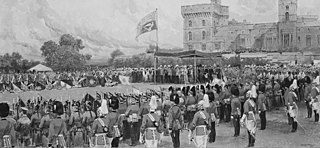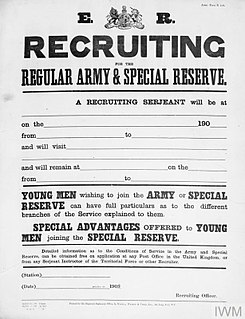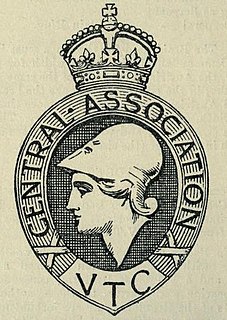
The Finnish Defence Forces are the military of Finland. The Finnish Defence Forces consist of the Finnish Army, the Finnish Navy and the Finnish Air Force. In wartime the Finnish Border Guard becomes part of the Finnish Defence Forces.

A militia is generally an army or some other fighting organization of non-professional soldiers, citizens of a country, or subjects of a state, who may perform military service during a time of need, as opposed to a professional force of regular, full-time military personnel; or, historically, to members of a warrior-nobility class. Generally unable to hold ground against regular forces, militias commonly support regular troops by skirmishing, holding fortifications, or conducting irregular warfare, instead of undertaking offensive campaigns by themselves. Local civilian laws often limit militias to serve only in their home region, and to serve only for a limited time; this further reduces their use in long military campaigns.

The Army Reserve is the active-duty volunteer reserve force of the British Army. It is separate from the Regular Reserve whose members are ex-Regular personnel who retain a statutory liability for service. The Army Reserve was known as the Territorial Force from 1908 to 1921, the Territorial Army (TA) from 1921 to 1967, the Territorial and Army Volunteer Reserve (TAVR) from 1967 to 1979, and again the Territorial Army (TA) from 1979 to 2014.

The Territorial Force was a part-time volunteer component of the British Army, created in 1908 to augment British land forces without resorting to conscription. The new organisation consolidated the 19th-century Volunteer Force and yeomanry into a unified auxiliary, commanded by the War Office and administered by local County Territorial Associations. The Territorial Force was designed to reinforce the regular army in expeditionary operations abroad, but because of political opposition it was assigned to home defence. Members were liable for service anywhere in the UK and could not be compelled to serve overseas. In the first two months of the First World War, territorials volunteered for foreign service in significant numbers, allowing territorial units to be deployed abroad. They saw their first action on the Western Front during the initial German offensive of 1914, and the force filled the gap between the near destruction of the regular army that year and the arrival of the New Army in 1915. Territorial units were deployed to Gallipoli in 1915 and, following the failure of that campaign, provided the bulk of the British contribution to allied forces in the Sinai and Palestine Campaign. By the war's end, the Territorial Force had fielded twenty-three infantry divisions and two mounted divisions on foreign soil. It was demobilised after the war and reconstituted in 1921 as the Territorial Army.

The Army Reserve (AR) is the reserve land component of the Irish Defence Forces. It is the second line reserve of the Irish Army. The Army Reserve involves active military service on a part-time basis, and is one of two elements of the Reserve Defence Forces, the other element being the Naval Service Reserve (NSR).

The Australian Army Reserve is a collective name given to the reserve units of the Australian Army. Since the Federation of Australia in 1901, the reserve military force has been known by many names, including the Citizens Forces, the Citizen Military Forces, the Militia and, unofficially, the Australian Military Forces. In 1980, however, the current name—Australian Army Reserve—was officially adopted, and it now consists of a number of components based around the level of commitment and training obligation that its members are required to meet.

The 48th Division was an infantry division of the British Army. Part of the Territorial Force (TF) and raised in 1908, the division was originally called the South Midland Division, and was redesignated as the 48th Division in 1915. During the First World War, the division saw service on the Western Front before being transferred to the Italian Front in November 1917 and remaining there for the rest of the war.

A reservist is a person who is a member of a military reserve force. They are otherwise civilians, and in peacetime have careers outside the military. Reservists usually go for training on an annual basis to refresh their skills. This person is usually a former active-duty member of the armed forces, and they remain a reservist either voluntarily, or by obligation. In some countries such as Israel, Norway, Finland, Singapore, and Switzerland, reservists are conscripted soldiers who are called up for training and service when necessary.

A military reserve force is a military organization whose members simultaneously hold military and civilian occupations. These members are not normally kept under arms and their main role is to be available to fight when their military requires additional manpower. Reserve forces are generally considered part of a permanent standing body of armed forces. The existence of reserve forces allows a nation to reduce its peacetime military expenditures while maintaining a force prepared for war.
The Royal Defence Corps was a corps of the British Army formed in 1916 and disbanded in 1936.

The Primary Reserve of the Canadian Armed Forces is the first and largest of the four sub-components of the Canadian Forces reserves, followed by the Supplementary Reserve, the Cadet Organizations Administration and Training Service and the Canadian Rangers.

The Territorial and Reserve Forces Act 1907 was an Act of the Parliament of the United Kingdom that reformed the auxiliary forces of the British Army by transferring existing Volunteer and Yeomanry units into a new Territorial Force (TF); and disbanding the Militia to form a new Special Reserve of the Regular Army. This reorganisation formed a major part of the Haldane Reforms, named after the creator of the Act, Richard Haldane.

The Special Reserve was established on 1 April 1908 with the function of maintaining a reservoir of manpower for the British Army and training replacement drafts in times of war. Its formation was part of the military reforms implemented by Richard Haldane, the Secretary of State for War, which also created the Territorial Force. Haldane originally intended that the Militia would provide the reserve, but opposition from its representatives forced him to abolish it and create the Special Reserve instead. Only 60 per cent of the Militia transferred into the new reserve, and it was consistently under strength, particularly in officers. Reservists enlisted for a six-year term of service, and had to undergo six months of basic training on recruitment and three to four weeks training annually. The Special Reserve was organised into battalions, providing a third for each of the regular army's 64 two-battalion infantry regiments and a fifth and sixth for the five four-battalion infantry regiments. In addition to providing replacements to the regular army, the Special Reserve was deployed on home defence duties guarding the coast and key installations during the First World War. The routine nature of its duties meant that scant attention was paid to it in regimental histories. After the war, the Special Reserve was abolished and the Militia was resurrected in 1921 to take on its former role. No effort was made to restart recruitment, and in 1924 the new Militia's functions were absorbed into the Supplementary Reserve.
The Militia of the United Kingdom were the military reserve forces of the United Kingdom of Great Britain and Ireland after the Union in 1801 of the former Kingdom of Great Britain and Kingdom of Ireland. The militia was transformed into the Special Reserve by the Territorial and Reserve Forces Act 1907. For the period before the creation of the United Kingdom, in the home nations and their colonies, see Militia.

The Haldane Reforms were a series of far-ranging reforms of the British Army made from 1906 to 1912, and named after the Secretary of State for War, Richard Burdon Haldane. They were the first major reforms since the "Childers Reforms" of the early 1880s, and were made in the light of lessons newly learned in the Second Boer War.
The reserve components of the United States Armed Forces are military organizations whose members generally perform a minimum of 39 days of military duty per year and who augment the active duty military when necessary. The reserve components are also referred to collectively as the National Guard and Reserve.

The Volunteer Training Corps was a voluntary home defence militia in the United Kingdom during World War I.
The Home Service Battalions were a force of the British Army in both the First and Second World Wars, intended for home defence and other duties. Those who joined these battalions were exempted from service outside of the United Kingdom.

Until 1689, mutiny was regulated in England by Articles of War instituted by the monarch and effective only in a period of war. This abuse of the crown's prerogative caused Parliament to pass the Petition of Right in 1628. This Act stated that neither civilians nor soldiers and officers who were in England during peace were subject to military courts or law. Only common-law courts and courts of equity could exercise authority over individuals in peacetime England. Because the articles of war did not fall under these court's jurisdiction, military law couldn't be applied to anyone in England, whether soldier or civilian.
The British home army in the First World War served the dual purpose of defending the country against invasion and training reinforcements for the army overseas. Initial responsibility for defending the nation lay with the Territorial Force, a part-time auxiliary designed in 1908 as a means of expanding the army in a major foreign conflict but, as a result of political compromise, implemented as a home defence army. It was supported in this role by 42,000 regular army troops, primarily belonging to the Royal Garrison Artillery and the Royal Engineers. The 14 infantry divisions and 14 mounted brigades of the Territorial Force were mainly allocated either to the Local Force, stationed near the coast and tasked with disrupting an invasion at the point of landing, or the Central Force, a mobile element tasked with defeating the invading force as it marched on London. The Local Force was augmented by units of the Special Reserve and Extra Reserve, which were the third battalions of the regular army line infantry regiments established to recruit and train replacements for their regiments' two combat battalions. The home army was also largely responsible for guarding vulnerable points, such as the communications infrastructure, rail network and munitions works.















